《英语翻译》课程教学资源(名作佳译)鹿鼎记 The Deer and the Cauldron,The First Book,A Martial Arts novel
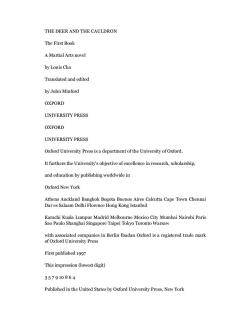
THEDEERANDTHECAULDRONThe First BookA Martial Arts novelbyLouis ChaTranslated and editedby John MinfordOXPORDUNIVERSITYPRESSOXFORDUNIVERSITYPRESSOxfordUniversityPress isadepartmentoftheUniversityofOxford.It furthers the University's objective ofexcellence in research, scholarship,and educationbypublishingworldwideinOxford New YorkAthens Auckland Bangkok Bogota Buenos Aires Calcutta Cape Town ChennaiDar es SalaamDelhi FlorenceHongKong IstanbulKarachi Kuala Lumpur Madrid Melbourne Mexico City Mumbai Nairobi ParisSao Paulo Shanghai Singapore Taipei Tokyo Toronto Warsawwith associated companies in Berlin Ibadan Oxford is a registered trade markofOxfordUniversityPressFirst published 1997This impression (lowest digit)357910864PublishedintheUnitedStatesbyOxfordUniversityPress,NewYork
THE DEER AND THE CAULDRON The First Book A Martial Arts novel by Louis Cha Translated and edited by John Minford OXPORD UNIVERSITY PRESS OXFORD UNIVERSITY PRESS Oxford University Press is a department of the University of Oxford. It furthers the University's objective of excellence in research, scholarship, and education by publishing worldwide in Oxford New York Athens Auckland Bangkok Bogota Buenos Aires Calcutta Cape Town Chennai Dar es Salaam Delhi Florence Hong Kong Istanbul Karachi Kuala Lumpur Madrid Melbourne Mexico City Mumbai Nairobi Paris Sao Paulo Shanghai Singapore Taipei Tokyo Toronto Warsaw with associated companies in Berlin Ibadan Oxford is a registered trade mark of Oxford University Press First published 1997 This impression (lowest digit) 3 5 7 9 10 8 6 4 Published in the United States by Oxford University Press, New York

knight-errant employs Martial Arts skills to achieve that chivalrous, altruisticend,that is a fit subject for Martial Arts fiction.The Deer and the Cauldron presents Chinese culture in an overripe phase.There is something distinctly decadent about many of the characters and thephenomena portrayed in the novel. Deer seeks, often in caricature, to conveysomething of the less-admirable human qualities that were manifested duringthis early encounter between China and various less-developed non-Chinesepeoples.I am most grateful to John Minford for all the time and effort he has put intotranslating this novel of mine into English. His father-in-law David Hawkes hasalso honoured me greatly by contributing so much to thetranslation, although(in the spirit of modesty to be expected of such a fine scholar) he has notwished his name to appear on the book itself. Some years ago when I was atOxford University, I had hoped I might be able to be one of his students. Alashe had already retired into the Welsh hills! I must also thank his daughterRachel, John's wife,for the excellent job she has done as editor. And finally,mythanks go to Oxford University Press, for agreeing to publish my work, It willbring me happiness if Western readers can discover in these pages somethingof what makes this form of fiction so especially Chinese.LouisCHAHong Kong August 1997CONTENTSAuthor'sPrefaceTranslator's IntroductionImportant Dates in the Historical BackgroundGlossaryof Peopleand PlacesGeneralGlossaryofTermsNote on PronunciationPrologue-In which Three Ming Loyalists discuss the Manchu Persecution, theMing History, the Beggars Guild, and the Triad Secret SocietyThe Deer and the Cauldron-The Ming History-By the Slow Process-The
knight-errant employs Martial Arts skills to achieve that chivalrous, altruistic end, that is a fit subject for Martial Arts fiction. The Deer and the Cauldron presents Chinese culture in an overripe phase. There is something distinctly decadent about many of the characters and the phenomena portrayed in the novel. Deer seeks, often in caricature, to convey something of the less-admirable human qualities that were manifested during this early encounter between China and various less-developed non-Chinese peoples. I am most grateful to John Minford for all the time and effort he has put into translating this novel of mine into English. His father-in-law David Hawkes has also honoured me greatly by contributing so much to the translation, although (in the spirit of modesty to be expected of such a fine scholar) he has not wished his name to appear on the book itself. Some years ago when I was at Oxford University, I had hoped I might be able to be one of his students. Alas, he had already retired into the Welsh hills! I must also thank his daughter Rachel, John's wife, for the excellent job she has done as editor. And finally, my thanks go to Oxford University Press, for agreeing to publish my work. It will bring me happiness if Western readers can discover in these pages something of what makes this form of fiction so especially Chinese. Louis CHA Hong Kong August 1997 CONTENTS Author's Preface Translator's Introduction Important Dates in the Historical Background Glossary of People and Places General Glossary of Terms Note on Pronunciation Prologue—In which Three Ming Loyalists discuss the Manchu Persecution, the Ming History, the Beggars Guild, and the Triad Secret Society The Deer and the Cauldron—The Ming History—By the Slow Process—The
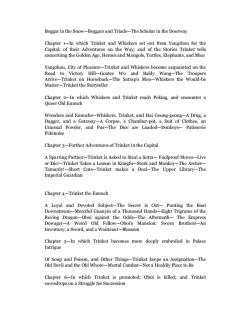
Beggar inthe Snow-Beggars andTriads-The Scholarin theDoorwayChapter 1-In which Trinket and Whiskers set out from Yangzhou for theCapital; of their Adventures on the Way; and of the Stories Trinket tellsconcerning the Golden Age, Heroes and Mongols, Turtles, Elephants, and MiceYangzhou, City of Pleasure-Trinket and Whiskers become acquainted on theRoad toVictoryHill-GoateeWuandBaldyWang-TheTroopersArrive-Trinket on Horseback-The Satrap's Men-Whiskers the Would-beMaster-Trinket the StorytellerChapter 2-In which Whiskers and Trinket reach Peking, and encounter aQueerOldEunuchWresders and Eunuchs-Whiskers, Trinket, and Hai Goong-goong-A Drug,aDagger, and a Getaway-A Corpse, a Chamber-pot, a Suit of Clothes, anUnusual Powder, and Pus-The Dice are Loaded-Donkeys-PatisseriePekinoiseChapter3-FurtherAdventuresofTrinketintheCapitalA Sparring Partner-Trinket is Asked to Steal a Sutra-Foolproof Moves-Liveor Die!-TrinketTakesa Lesson inKungfu-Stork and Monkey-TheArcher-Tamardy!-Short Cuts-Trinket makes a Deal-The Upper Library-TheImperial GuardianChapter 4-Trinket the EunuchA Loyal and Devoted Subject-The Secret is Out- Punting the BoatDownstream-MercifulGuanyinofaThousandHands-EightTrigramsoftheRoving Dragon-Oboi against the Odds-The Aftermath- The EmpressDowager-A Weird Old Fellow-Oboi's Mansion:Sworn Brothers-AnInventory, a Sword, and a Waistcoat-BlossomChapter 5-Inwhich Trinketbecomes more deeply embroiled in PalaceIntrigueOf Soup and Poison, and Other Things-Trinket keeps an Assignation-TheOld Devil and the Old Whore-Mortal Combat-Not a Healdiy Place to BeChapter 6-In which Trinket is promoted; Oboi is killed; and Trinketeavesdropsona StruggleforSuccession
Beggar in the Snow—Beggars and Triads—The Scholar in the Doorway Chapter 1—In which Trinket and Whiskers set out from Yangzhou for the Capital; of their Adventures on the Way; and of the Stories Trinket tells concerning the Golden Age, Heroes and Mongols, Turtles, Elephants, and Mice Yangzhou, City of Pleasure—Trinket and Whiskers become acquainted on the Road to Victory Hill—Goatee Wu and Baldy Wang—The Troopers Arrive—Trinket on Horseback—The Satrap's Men—Whiskers the Would-be Master—Trinket the Storyteller Chapter 2—In which Whiskers and Trinket reach Peking, and encounter a Queer Old Eunuch Wresders and Eunuchs—Whiskers, Trinket, and Hai Goong-goong—A Drug, a Dagger, and a Getaway—A Corpse, a Chamber-pot, a Suit of Clothes, an Unusual Powder, and Pus—The Dice are Loaded—Donkeys— Patisserie Pekinoise Chapter 3—Further Adventures of Trinket in the Capital A Sparring Partner—Trinket is Asked to Steal a Sutra— Foolproof Moves—Live or Die!—Trinket Takes a Lesson in Kungfu—Stork and Monkey—The Archer— Tamardy!—Short Cuts—Trinket makes a Deal—The Upper Library—The Imperial Guardian Chapter 4—Trinket the Eunuch A Loyal and Devoted Subject—The Secret is Out— Punting the Boat Downstream—Merciful Guanyin of a Thousand Hands—Eight Trigrams of the Roving Dragon—Oboi against the Odds—The Aftermath— The Empress Dowager—A Weird Old Fellow—Oboi's Mansion: Sworn Brothers—An Inventory, a Sword, and a Waistcoat—Blossom Chapter 5—In which Trinket becomes more deeply embroiled in Palace Intrigue Of Soup and Poison, and Other Things—Trinket keeps an Assignation—The Old Devil and the Old Whore—Mortal Combat—Not a Healdiy Place to Be Chapter 6—In which Trinket is promoted; Oboi is killed; and Trinket eavesdrops on a Struggle for Succession
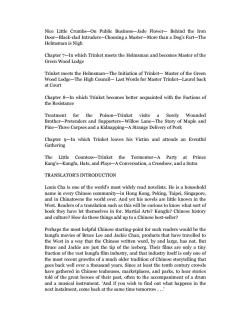
Nice Little Crumbs-On Public Business-Jade Flower- Behind the IronDoor-Black-clad Intruders-Choosing a Master-More than a Dog's Fart-TheHelmsman is NighChapter 7-In which Trinket meets the Helmsman and becomes Master of theGreen Wood LodgeTrinket meets the Helmsman-The Initiation of Trinket-Master of the GreenWood Lodge-The High Council- Last Words for Master Trinket-Laurel backat CourtChapter 8-In which Trinket becomes better acquainted with the Factions oftheResistanceTreatmentforthePoison-TrinketvisitsaSorelyWoundedBrother-Pretenders and Supporters-Willow Lane-The Story of Maple andPine-Three Corpses and a Kidnapping-A Strange Delivery of PorkChapter 9-In which Trinket leaves his Victim and attends an EventfulGatheringTheLittleCountess-TrinkettheTormentor-AParty atPrinceKang's-Kungfu, Hats, and Plays-A Conversation, a Crossbow, and a SutraTRANSLATOR'SINTRODUCTIONLouisChais oneof theworld'smostwidelyread novelists.Heisahouseholdname in every Chinese community-in Hong Kong,Peking, Taipei, Singapore,and in Chinatowns the world over. And yet his novels are little known in theWest.Readersofatranslationsuchasthiswillbecurioustoknowwhatsortofbooktheyhave let themselves in for.Martial Arts?Kungfu?Chinese historyand culture? How do these things add up to a Chinese best-seller?Perhaps the most helpful Chinese starting-point for such readers would be thekungfumoviesofBruceLeeandJackieChan,productsthathavetravelledtothe West in a way that the Chinese written word, by and large, has not. ButBruce and Jackie are just the tip of the iceberg. Their films are only a tinyfraction of the vast kungfu film industry, and that industry itself is only one ofthe most recent growths of a much older tradition of Chinese storytelling thatgoes back well over a thousand years. Since at least the tenth century crowdshavegatheredinChineseteahouses,marketplaces,andparks,tohearstoriestold of the great heroes of their past, often to the accompaniment of a drumand a musical instrument. 'And if you wish to find out what happens in thenext instalment, comeback at the sametime tomorrow
Nice Little Crumbs—On Public Business—Jade Flower— Behind the Iron Door—Black-clad Intruders—Choosing a Master—More than a Dog's Fart—The Helmsman is Nigh Chapter 7—In which Trinket meets the Helmsman and becomes Master of the Green Wood Lodge Trinket meets the Helmsman—The Initiation of Trinket— Master of the Green Wood Lodge—The High Council— Last Words for Master Trinket—Laurel back at Court Chapter 8—In which Trinket becomes better acquainted with the Factions of the Resistance Treatment for the Poison—Trinket visits a Sorely Wounded Brother—Pretenders and Supporters—Willow Lane—The Story of Maple and Pine—Three Corpses and a Kidnapping—A Strange Delivery of Pork Chapter 9—In which Trinket leaves his Victim and attends an Eventful Gathering The Little Countess—Trinket the Tormentor—A Party at Prince Kang's—Kungfu, Hats, and Plays—A Conversation, a Crossbow, and a Sutra TRANSLATOR'S INTRODUCTION Louis Cha is one of the world's most widely read novelists. He is a household name in every Chinese community—in Hong Kong, Peking, Taipei, Singapore, and in Chinatowns the world over. And yet his novels are little known in the West. Readers of a translation such as this will be curious to know what sort of book they have let themselves in for. Martial Arts? Kungfu? Chinese history and culture? How do these things add up to a Chinese best-seller? Perhaps the most helpful Chinese starting-point for such readers would be the kungfu movies of Bruce Lee and Jackie Chan, products that have travelled to the West in a way that the Chinese written word, by and large, has not. But Bruce and Jackie are just the tip of the iceberg. Their films are only a tiny fraction of the vast kungfu film industry, and that industry itself is only one of the most recent growths of a much older tradition of Chinese storytelling that goes back well over a thousand years. Since at least the tenth century crowds have gathered in Chinese teahouses, marketplaces, and parks, to hear stories told of the great heroes of their past, often to the accompaniment of a drum and a musical instrument. 'And if you wish to find out what happens in the next instalment, come back at the same time tomorrow . .
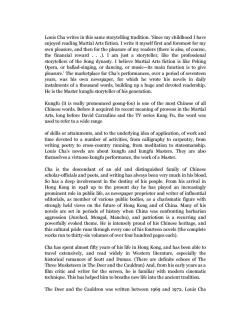
Louis Cha writes in this same storytelling tradition. 'Since my childhood I haveenjoyed reading Martial Arts fiction. I write it myself first and foremost for myown pleasure, and then for the pleasure ofmy readers (there is also, of course,the financial reward . . .). I am just a storyteller, like the professionalstorytellers of the Song dynasty. I believe Martial Arts fiction is like PekingOpera, or ballad-singing, or dancing, or music-its main function is to givepleasure.The marketplace for Cha's performances, over a period of seventeenyears, was his own newspaper, for which he wrote his novels in dailyinstalments of a thousand words, building up a huge and devoted readershipHeisthe Masterkungfu storyteller of his generation.Kungfu (it is really pronounced goong-foo) is one of the most Chinese of allChinese words.Before it acquired its recent meaning of prowess in the MartialArts, long before David Carradine and the TV series Kung Fu, the word wasusedtoreferto a widerangeof skills or attainments, and to the underlying idea of application, of work andtime devoted to a number of activities, from calligraphy to carpentry, fromwriting poetry to cross-country running, from meditation to statesmanship.Louis Cha's novels are about kungfu and kungfu Masters. They are alsothemselves a virtuoso kungfu performance, the work of a Master.Cha is the descendant of an old and distinguished family of Chinesescholar-officials and poets, and writing has always been very much in his blood.So has a deep involvement in the destiny of his people. From his arrival inHong Kong in 1948 up to the present day he has played an increasinglyprominent role in public life, as newspaper proprietor and writer of influentialeditorials, as member of various public bodies, as a charismatic figure withstrongly held views on the future of Hong Kong and of China.Many of hisnovels are set in periods of history when China was confrontingbarbarianaggression (Jurched, Mongol, Manchu), and patriotism is a recurring andpowerfully evoked theme. He is intensely proud of his Chinese heritage, andthis cultural pride runs through every one of his fourteen novels (the completeworks run to thirty-six volumes of over four hundred pages each).Cha has spent almost fifty years of his life in Hong Kong, and has been able totravel extensively, and read widely in Western literature, especially thehistoricalromancesof Scottand Dumas.(Therearedefinite echoesof TheThree Musketeers in The Deer and the Cauldron) And, from his early years as afilm critic and writer for the screen, he is familiar with modern cinematictechnique.Thishas helped him to breathe new life into the ancient tradition.The Deer and the Cauldron was written between 1969 and 1972. Louis Cha
Louis Cha writes in this same storytelling tradition. 'Since my childhood I have enjoyed reading Martial Arts fiction. I write it myself first and foremost for my own pleasure, and then for the pleasure of my readers (there is also, of course, the financial reward . . .). I am just a storyteller, like the professional storytellers of the Song dynasty. I believe Martial Arts fiction is like Peking Opera, or ballad-singing, or dancing, or music—its main function is to give pleasure.' The marketplace for Cha's performances, over a period of seventeen years, was his own newspaper, for which he wrote his novels in daily instalments of a thousand words, building up a huge and devoted readership. He is the Master kungfu storyteller of his generation. Kungfu (it is really pronounced goong-foo) is one of the most Chinese of all Chinese words. Before it acquired its recent meaning of prowess in the Martial Arts, long before David Carradine and the TV series Kung Fu, the word was used to refer to a wide range of skills or attainments, and to the underlying idea of application, of work and time devoted to a number of activities, from calligraphy to carpentry, from writing poetry to cross-country running, from meditation to statesmanship. Louis Cha's novels are about kungfu and kungfu Masters. They are also themselves a virtuoso kungfu performance, the work of a Master. Cha is the descendant of an old and distinguished family of Chinese scholar-officials and poets, and writing has always been very much in his blood. So has a deep involvement in the destiny of his people. From his arrival in Hong Kong in 1948 up to the present day he has played an increasingly prominent role in public life, as newspaper proprietor and writer of influential editorials, as member of various public bodies, as a charismatic figure with strongly held views on the future of Hong Kong and of China. Many of his novels are set in periods of history when China was confronting barbarian aggression (Jurched, Mongol, Manchu), and patriotism is a recurring and powerfully evoked theme. He is intensely proud of his Chinese heritage, and this cultural pride runs through every one of his fourteen novels (the complete works run to thirty-six volumes of over four hundred pages each). Cha has spent almost fifty years of his life in Hong Kong, and has been able to travel extensively, and read widely in Western literature, especially the historical romances of Scott and Dumas. (There are definite echoes of The Three Musketeers in The Deer and the Cauldron} And, from his early years as a film critic and writer for the screen, he is familiar with modern cinematic technique. This has helped him to breathe new life into the ancient tradition. The Deer and the Cauldron was written between 1969 and 1972. Louis Cha

insists that it will remain his last Martial Arts novel. It is also his mostmischievous, and in many ways his least typical work. But it is stillunmistakably and authentically Cha. Perhaps that is the most importantquality of all of Cha's work. It is an authentic Chinese banquet not a take-away.Through the act of storytelling, Cha reaffirms an essential Chinese culturalidentity. Beneath the excitement and humour of his stories lies a whole world.AsaMainland criticputit,'Louis Cha'switand humourarebased ontheinnerrealm of Buddhist and Taoist philosophy. Behind the clownish, fool-likeexterior lies agreat subtletyand refinement.'The Deer and the Cauldron is set in the mid-seventeenth century.The Manchushave been ruling China for a little over twenty years,and aregradually (thoughruthlessly) managing to put out the last residual sparks of the ChineseResistance, in the South and the South-West. The Prologue, which was writtenduring the height of the early excesses of the Cultural Revolution, describes ingruesome detail the persecution of Loyalist intellectuals during the 166os. (It isworth mentioning here that the Prologue, while setting the historical scenevery effectively, is written in a very different style from the rest of the book.Readers impatient for a taste of kungfu low life will have to wait until the firstchapter.) On the Dragon Throne at the opening of the novel is the youngManchu Emperor Kang Xi. Principal among the underground organizationsfighting Manchu rule is the newly formed Triad Secret Society. The novelweaves its way through a host of historical events, culminating (at the end ofthe third volume) in the Treaty of Nerchinsk, signed between China and Russiaintheyear168g.Holdingalltheseepisodestogetherisawonderfulcharacterof Louis Cha's invention,Trinket, an incorrigible scamp,the opportunistic, lazy,but ultimately likeable and unforgettable, son of a singsong-girl from theSouthern city of Yangzhou. As Louis Cha himself has written, 'Frankly, when IstartedwritingDeer,duringthefirstfewmonths,Ihadnoclearnotionofwhatsort of character Trinket was going to be: he just grew on me slowly, bit by bit..He has many of the common Chinese qualities and failings, but he is certainlynot meant to be a "type" of the Chinese people.'Trinket somehow manages tohave a finger in every available pie, and builds out of his multiple identities anabsorbing and extraordinary card-castle of a life. It is his personality above allthat turns the book into what the distinguished Hong Kong critic StephenSoong has called 'a roller-coaster of a novel, packed with thrills, with fun, rage,humour, and abuse, written in a style that flows and flashes like quicksilver.This English version of The Deer and the Cauldron will be in three volumes. Itwill eventually be joined in the series by others, including Book and Sword(Louis Cha's first novel, written in 1955, translated by Graham Earnshaw) andthe diree-volume Eagles and Heroes (1957-1959, translated by Sharon Lai andmyself).Through these versions, we hope to give English readers a glimpse ofthe rich Chinese cultural tapestry that is Cha's kungfu world
insists that it will remain his last Martial Arts novel. It is also his most mischievous, and in many ways his least typical work. But it is still unmistakably and authentically Cha. Perhaps that is the most important quality of all of Cha's work. It is an authentic Chinese banquet not a take-away. Through the act of storytelling, Cha reaffirms an essential Chinese cultural identity. Beneath the excitement and humour of his stories lies a whole world. As a Mainland critic put it, 'Louis Cha's wit and humour are based on the inner realm of Buddhist and Taoist philosophy. Behind the clownish, fool-like exterior lies a great subtlety and refinement.' The Deer and the Cauldron is set in the mid-seventeenth century. The Manchus have been ruling China for a little over twenty years,and are gradually (though ruthlessly) managing to put out the last residual sparks of the Chinese Resistance, in the South and the South-West. The Prologue, which was written during the height of the early excesses of the Cultural Revolution, describes in gruesome detail the persecution of Loyalist intellectuals during the 1660s. (It is worth mentioning here that the Prologue, while setting the historical scene very effectively, is written in a very different style from the rest of the book. Readers impatient for a taste of kungfu low life will have to wait until the first chapter.) On the Dragon Throne at the opening of the novel is the young Manchu Emperor Kang Xi. Principal among the underground organizations fighting Manchu rule is the newly formed Triad Secret Society. The novel weaves its way through a host of historical events, culminating (at the end of the third volume) in the Treaty of Nerchinsk, signed between China and Russia in the year 1689. Holding all these episodes together is a wonderful character of Louis Cha's invention, Trinket, an incorrigible scamp, the opportunistic, lazy, but ultimately likeable and unforgettable, son of a singsong-girl from the Southern city of Yangzhou. As Louis Cha himself has written, 'Frankly, when I started writing Deer, during the first few months, I had no clear notion of what sort of character Trinket was going to be: he just grew on me slowly, bit by bit. He has many of the common Chinese qualities and failings, but he is certainly not meant to be a "type" of the Chinese people.' Trinket somehow manages to have a finger in every available pie, and builds out of his multiple identities an absorbing and extraordinary card-castle of a life. It is his personality above all that turns the book into what the distinguished Hong Kong critic Stephen Soong has called 'a roller-coaster of a novel, packed with thrills, with fun, rage, humour, and abuse, written in a style that flows and flashes like quicksilver.' This English version of The Deer and the Cauldron will be in three volumes. It will eventually be joined in the series by others, including Book and Sword (Louis Cha's first novel, written in 1955, translated by Graham Earnshaw) and the diree-volume Eagles and Heroes (1957-1959, translated by Sharon Lai and myself). Through these versions, we hope to give English readers a glimpse of the rich Chinese cultural tapestry that is Cha's kungfu world
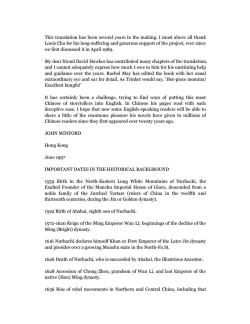
This translation has been several years in the making. I must above all thankLouis Cha for his long-suffering and generous support of the project, ever sincewefirstdiscussed it inApril1989.MydearfriendDavid Hawkeshascontributed manychapters ofthetranslation,and I cannot adequately express how much Iowe to him for his unstinting helpand guidance over the years. Rachel May has edited the book with her usuaextraordinary eye and ear for detail. As Trinket would say,'Hot-piece momma!Excellent kungfu!'It has certainly been a challenge, trying to find ways of putting this mostChinese of storytellers into English. In Chinese his pages read with suchdeceptive ease.I hope that now some English-speaking readers will be able toshare a little of the enormous pleasure his novels have given to millions ofChinese readers since they first appeared over twenty years ago.JOHNMINFORDHong KongJune1997IMPORTANTDATESINTHEHISTORICALBACKGROUND1559Birth in the North-Eastern Long White Mountains of Nurhachi,theExalted Founder of the Manchu Imperial House of Gioro, descended from anoble family of the Jurched Tartars (rulers of China in the twelfth andthirteenth centuries, during the Jin or Golden dynasty).1592 Birth of Abahai, eighth son of Nurhachi.1572-1620 Reign of the Ming Emperor Wan Li; beginnings of the decline of theMing (Bright) dynasty.1616Nurhachi declareshimself KhanorFirst Emperorofthe Later Jin dynastyand presides overa growing Manchu state in the North-Fa St.1626 Death of Nurhachi, who is succeeded by Abahai, the Illustrious Ancestor.1628 Accession of Chong Zhen, grandson of Wan Li, and last Emperor of thenative (Han) Ming dynasty.1636 Rise of rebel movements in Northern and Central China, including that
This translation has been several years in the making. I must above all thank Louis Cha for his long-suffering and generous support of the project, ever since we first discussed it in April 1989. My dear friend David Hawkes has contributed many chapters of the translation, and I cannot adequately express how much I owe to him for his unstinting help and guidance over the years. Rachel May has edited the book with her usual extraordinary eye and ear for detail. As Trinket would say, 'Hot-piece momma! Excellent kungfu!' It has certainly been a challenge, trying to find ways of putting this most Chinese of storytellers into English. In Chinese his pages read with such deceptive ease. I hope that now some English-speaking readers will be able to share a little of the enormous pleasure his novels have given to millions of Chinese readers since they first appeared over twenty years ago. JOHN MINFORD Hong Kong June 1997 IMPORTANT DATES IN THE HISTORICAL BACKGROUND 1559 Birth in the North-Eastern Long White Mountains of Nurhachi, the Exalted Founder of the Manchu Imperial House of Gioro, descended from a noble family of the Jurched Tartars (rulers of China in the twelfth and thirteenth centuries, during the Jin or Golden dynasty). 1592 Birth of Abahai, eighth son of Nurhachi. 1572-1620 Reign of the Ming Emperor Wan Li; beginnings of the decline of the Ming (Bright) dynasty. 1616 Nurhachi declares himself Khan or First Emperor of the Later Jin dynasty and presides over a growing Manchu state in the North-Fa St. 1626 Death of Nurhachi, who is succeeded by Abahai, the Illustrious Ancestor. 1628 Accession of Chong Zhen, grandson of Wan Li, and last Emperor of the native (Han) Ming dynasty. 1636 Rise of rebel movements in Northern and Central China, including that

led by Li Zicheng (General Bash-em); Abahai proclaims himself Emperor oftheQing (Clear) dynasty, in the Manchu capital Mukden (present-day Shenyang).1638 Birth of Fulin (later to be the Emperor Shun Zhi), fourth son of Abahai.1644 Rebel leader Li Zicheng enters Peking; the Emperor Chong Zhen commitssuicide; the Manchu army enters Peking, aided by the turncoat Satrap Wu andhis force of Chinese troops; beginning of the Manchu Qing dynasty proper inChina and of the reign of Shun Zhi.1646-1647 Manchu conquerors try to consolidatetheirhold over central andSouthern China; Ming Princes (Pretenders) establish short-lived refugee courtsinthe South.1654Birth ofXuanye(later tobeEmperorKangXi),second son of theEmperor ShunZhi.1659 Coxinga, leader of the anti-Manchu resistance, tries to take Nanking butfails.1661Death of Empress Donggo, the Emperor Shun Zhi's favourite consort; alsosupposeddeadiofEmperorShunZhi.1662 Accession of Kang Xi. Ming Pretender Prince Gui taken prisoner inBurma and strangled in Kunming,with theconnivance of Satrap Wu (acting onthe orders of Oboi the Regent). Coxinga moves his base to Taiwan. Death ofCoxinga; formation, under Coxinga's General, Helmsman Chen Jinnan, of theTriad Secret Society, committed to the overthrow of the Manchus and therestoration ofthe Ming Imperial House.1662-1663 Inquisition surrounding the Ming History.1663-1664 Dutch fleet helps Manchus drive Coxinga's son from Taiwan;Manchu rule is established throughout mainland China.1667 Kang Xi, aged thirteen,dismisses his Regents.1669 Death of OboiformerlyChief Regent.1673 Rebellion of Satrap Wu (Yunnan and Guizhou Provinces), Shang Zhixin(Guangdong Province),and Geng Jingzhong (Fujian Province)-the ThreeFeudatories.1681ThreeFeudatoriesare finallyputdown
led by Li Zicheng (General Bash-em); Abahai proclaims himself Emperor of the Qing (Clear) dynasty, in the Manchu capital Mukden (present-day Shenyang). 1638 Birth of Fulin (later to be the Emperor Shun Zhi), fourth son of Abahai. 1644 Rebel leader Li Zicheng enters Peking; the Emperor Chong Zhen commits suicide; the Manchu army enters Peking, aided by the turncoat Satrap Wu and his force of Chinese troops; beginning of the Manchu Qing dynasty proper in China and of the reign of Shun Zhi. 1646-1647 Manchu conquerors try to consolidate their hold over central and Southern China; Ming Princes (Pretenders) establish short-lived refugee courts in the South. 1654 Birth of Xuanye (later to be Emperor Kang Xi), second son of the Emperor Shun Zhi. 1659 Coxinga, leader of the anti-Manchu resistance, tries to take Nanking but fails. 1661 Death of Empress Donggo, the Emperor Shun Zhi's favourite consort; also supposed deadi of Emperor Shun Zhi. 1662 Accession of Kang Xi. Ming Pretender Prince Gui taken prisoner in Burma and strangled in Kunming, with the connivance of Satrap Wu (acting on the orders of Oboi the Regent). Coxinga moves his base to Taiwan. Death of Coxinga; formation, under Coxinga's General, Helmsman Chen Jinnan, of the Triad Secret Society, committed to the overthrow of the Manchus and the restoration of the Ming Imperial House. 1662-1663 Inquisition surrounding the Ming History. 1663-1664 Dutch fleet helps Manchus drive Coxinga's son from Taiwan; Manchu rule is established throughout mainland China. 1667 Kang Xi, aged thirteen, dismisses his Regents. 1669 Death of Oboi, formerly Chief Regent. 1673 Rebellion of Satrap Wu (Yunnan and Guizhou Provinces), Shang Zhixin (Guangdong Province), and Geng Jingzhong (Fujian Province)—the Three Feudatories. 1681 Three Feudatories are finally put down
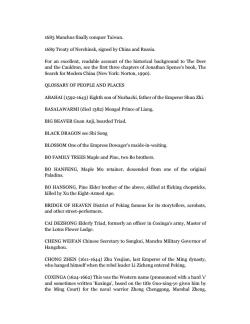
1683Manchus finally conquer Taiwan1689 Treaty of Nerchinsk, signed by China and Russia.For an excellent, readable account of the historical background to The Deerand the Cauldron, see the first three chapters of Jonathan Spence's book, TheSearch for Modem China (New York: Norton,1990).QLOSSARYOFPEOPLEANDPLACESABAHAI (1592-1643) Eighth son of Nurhachi, father of the Emperor Shun Zhi.BASALAWARMI (died 1382) Mongol Prince of LiangBIG BEAVER Guan Anji, bearded Triad.BLACKDRAGONseeShiSongBLOSSOMOneoftheEmpressDowager'smaids-in-waitingBOFAMILYTREESMapleandPine,twoBobrothersBO HANFENG, Maple Mu retainer, descended from one of the originalPaladins.BO HANSONG, Pine Elder brother of the above, skilled at flicking chopsticks,killed by Xu the Eight-Armed Ape.BRIDGE OF HEAVEN District of Peking famous for its storytellers,acrobats,and other street-performers.CAI DEZHONG Elderly Triad, formerly an officer in Coxinga's army, Master ofthe Lotus Flower Lodge.CHENGWEIFAN ChineseSecretary toSongkui, Manchu Military Governor ofHangzhou.CHONG ZHEN (1611-1644)ZhuYoujian, last Emperor of the Ming dynasty,whohanged himself when the rebel leader Li Zicheng entered Peking.COXINGA(1624-1662)This wasthe Western name (pronounced with a hard'cand sometimes written'Koxinga', based on the title Guo-xing-ye given him bythe Ming Court) for the naval warrior Zheng Chenggong, Marshal Zheng
1683 Manchus finally conquer Taiwan. 1689 Treaty of Nerchinsk, signed by China and Russia. For an excellent, readable account of the historical background to The Deer and the Cauldron, see the first three chapters of Jonathan Spence's book, The Search for Modem China (New York: Norton, 1990). QLOSSARY OF PEOPLE AND PLACES ABAHAI (1592-1643) Eighth son of Nurhachi, father of the Emperor Shun Zhi. BASALAWARMI (died 1382) Mongol Prince of Liang. BIG BEAVER Guan Anji, bearded Triad. BLACK DRAGON see Shi Song BLOSSOM One of the Empress Dowager's maids-in-waiting. BO FAMILY TREES Maple and Pine, two Bo brothers. BO HANFENG, Maple Mu retainer, descended from one of the original Paladins. BO HANSONG, Pine Elder brother of the above, skilled at flicking chopsticks, killed by Xu the Eight-Armed Ape. BRIDGE OF HEAVEN District of Peking famous for its storytellers, acrobats, and other street-performers. CAI DEZHONG Elderly Triad, formerly an officer in Coxinga's army, Master of the Lotus Flower Lodge. CHENG WEIFAN Chinese Secretary to Songkui, Manchu Military Governor of Hangzhou. CHONG ZHEN (1611-1644) Zhu Youjian, last Emperor of the Ming dynasty, who hanged himself when the rebel leader Li Zicheng entered Peking. COXINGA (1624-1662) This was the Western name (pronounced with a hard 'c' and sometimes written 'Koxinga', based on the title Guo-xing-ye given him by the Ming Court) for the naval warrior Zheng Chenggong, Marshal Zheng
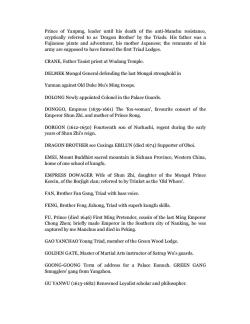
Prince of Yanpmg, leader until his death of the anti-Manchu resistance,cryptically referred to as 'Dragon Brother' by the Triads. His father was aFujianese pirate and adventurer, his mother Japanese; the remnants of hisarmy are supposed to have formed the first Triad Lodges.CRANE, Father Taoist priest at Wudang Temple.DELMEKMongolGeneraldefendingthe last Mongol stronghold inYunnan against old Duke Mu's Ming troops.DOLONGNewly appointedColonel inthe Palace GuardsDONGGO,Empress (1639-1661) The'fox-woman', favourite consort of theEmperor Shun Zhi, and motherof Prince Rong.DORGON (1612-165o) Fourteenth son of Nurhachi, regent during the earlyyears of Shun Zhi's reign.DRAGONBROTHER seeCoxingaEBILUN(died1674)SupporterofOboi.EMEI, Mount Buddhist sacred mountain in Sichuan Province, Western China,home ofone school of kungfu.EMPRESS DOWAGER Wife of Shun Zhi, daughter of the Mongol PrinceKorcin, of the Borjigit clan; referred to by Trinket as the'old Whore'.FAN, Brother Fan Gang, Triad with bass voice.FENG, Brother Feng Jizhong, Triad with superb kungfu skills.FU, Prince (died 1646)First Ming Pretender, cousin of the last Ming EmperorChong Zhen; briefly made Emperor in the Southern city of Nanking, he wascaptured by me Manchus and died in Peking.GAOYANCHAO Young Triad, member of the Green Wood LodgeGOLDEN GATE, Master of Martial Arts instructor of Satrap Wu's guards.GOONG-GOONGTerm of address for a Palace Eunuch.GREEN GANGSmugglers'gang from Yangzhou.GUYANwU (1613-1682)Renowned Loyalist scholar and philosopher
Prince of Yanpmg, leader until his death of the anti-Manchu resistance, cryptically referred to as 'Dragon Brother' by the Triads. His father was a Fujianese pirate and adventurer, his mother Japanese; the remnants of his army are supposed to have formed the first Triad Lodges. CRANE, Father Taoist priest at Wudang Temple. DELMEK Mongol General defending the last Mongol stronghold in Yunnan against Old Duke Mu's Ming troops. DOLONG Newly appointed Colonel in the Palace Guards. DONGGO, Empress (1639-1661) The 'fox-woman', favourite consort of the Emperor Shun Zhi, and mother of Prince Rong. DORGON (1612-1650) Fourteenth son of Nurhachi, regent during the early years of Shun Zhi's reign. DRAGON BROTHER see Coxinga EBILUN (died 1674) Supporter of Oboi. EMEI, Mount Buddhist sacred mountain in Sichuan Province, Western China, home of one school of kungfu. EMPRESS DOWAGER Wife of Shun Zhi, daughter of the Mongol Prince Korcin, of the Borjigit clan; referred to by Trinket as the 'Old Whore'. FAN, Brother Fan Gang, Triad with bass voice. FENG, Brother Feng Jizhong, Triad with superb kungfu skills. FU, Prince (died 1646) First Ming Pretender, cousin of the last Ming Emperor Chong Zhen; briefly made Emperor in the Southern city of Nanking, he was captured by me Manchus and died in Peking. GAO YANCHAO Young Triad, member of the Green Wood Lodge. GOLDEN GATE, Master of Martial Arts instructor of Satrap Wu's guards. GOONG-GOONG Term of address for a Palace Eunuch. GREEN GANG Smugglers' gang from Yangzhou. GU YANWU (1613-1682) Renowned Loyalist scholar and philosopher
按次数下载不扣除下载券;
注册用户24小时内重复下载只扣除一次;
顺序:VIP每日次数-->可用次数-->下载券;
- 《英语翻译》课程PPT教学课件(英汉翻译)1-2 翻译标准_2.ppt
- 《英语翻译》课程PPT教学课件(英汉翻译)2-1 翻译过程(理解2/2).ppt
- 《英语翻译》课程PPT教学课件(英汉翻译)4-2 语篇分析(1/2).ppt
- 《英语翻译》课程PPT教学课件(英汉翻译)2-2 翻译过程之文化语境.ppt
- 《英语翻译》课程PPT教学课件(英汉翻译)2-3 翻译过程之表达与审校.ppt
- 《英语翻译》课程PPT教学课件(英汉翻译)3 翻译方法.ppt
- 《英语翻译》课程PPT教学课件(英汉翻译)6 翻译的基本技巧 - 1/3.ppt
- 《英语翻译》课程PPT教学课件(英汉翻译)5-1 翻译的语言对比规律.ppt
- 《英语翻译》课程PPT教学课件(英汉翻译)4-2 语篇分析(2/2).ppt
- 《英语翻译》课程PPT教学课件(英汉翻译)5-2 翻译的语言对比规律supplement.ppt
- 《英语翻译》课程PPT教学课件(英汉翻译)6 翻译的基本技巧 - 2/3.ppt
- 《英语翻译》课程PPT教学课件(英汉翻译)7-8 克服翻译症、文体与翻译、文化与翻译.ppt
- 《英语翻译》课程PPT教学课件(英汉翻译)9-11 文化与翻译、忠实与叛逆、工具书的选择与运用.ppt
- 《英语翻译》课程PPT教学课件(英汉翻译)6 翻译的基本技巧 - 3/3.ppt
- 《英语翻译》课程PPT教学课件(汉英翻译)1-1 翻译定义.ppt
- 《英语翻译》课程PPT教学课件(汉英翻译)1-2 翻译标准.ppt
- 《英语翻译》课程PPT教学课件(汉英翻译)2-1 翻译过程之理解.ppt
- 《英语翻译》课程PPT教学课件(汉英翻译)2-2 翻译过程之文化语境.ppt
- 《英语翻译》课程PPT教学课件(汉英翻译)4-1 翻译单位.ppt
- 《英语翻译》课程PPT教学课件(汉英翻译)2-3 翻译过程之表达与审校.ppt
- 《大学英语翻译》课程教学大纲 English Interpreting(英语口译大纲).doc
- 《大学英语翻译》课程教学大纲 English-Chinese Translation(英汉翻译大纲).doc
- 《大学英语翻译》课程教学资源(汉英)我所知道的康桥.doc
- 《大学英语翻译》课程教学资源(汉英)搬家史.doc
- 《大学英语翻译》课程教学资源(汉英)钱钟书与杨绛.doc
- 《大学英语翻译》课程授课教案(英译汉)Unit 13 Translation of Long Sentences.doc
- 《大学英语翻译》课程授课教案(英译汉)Unit 10 Conversion of Attributive Clauses.doc
- 《大学英语翻译》课程授课教案(英译汉)Unit 9 Splitting.doc
- 《大学英语翻译》课程授课教案(英译汉)Units 11 and 12 Nominal Clauses and Adverbial Clauses.doc
- 《大学英语翻译》课程授课教案(英译汉)Unit 8 Affirmative vs negative.doc
- 《大学英语翻译》课程授课教案(英译汉)Unit 7 Passive Voice.doc
- 《大学英语翻译》课程授课教案(英译汉)Unit 5 Conversion.doc
- 《大学英语翻译》课程授课教案(英译汉)Unit 6 Restructuring.doc
- 《大学英语翻译》课程授课教案(英译汉)Unit 1Introduction.doc
- 《大学英语翻译》课程授课教案(英译汉)Units 3 and 4 Amplification and Omission.doc
- 《大学英语翻译》课程授课教案(英译汉)Unit 2 Diction.doc
- 《大学英语翻译》课程授课教案(汉译英)第5讲 信息结构与翻译.doc
- 《大学英语翻译》课程授课教案(汉译英)第3讲 句子衔接和布局.doc
- 《大学英语翻译》课程授课教案(汉译英)第4讲 词性转换.doc
- 《大学英语翻译》课程授课教案(汉译英)第6讲 长句的翻译.doc
